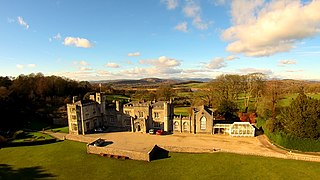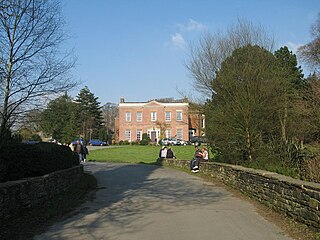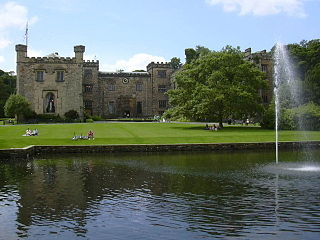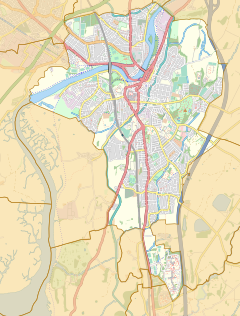Halton Hall was an English country house that stood in the grounds of the Halton Hall Estates and Manor for several centuries on the "right bank of the River Lune to the south of the church" in Halton, Lancashire.

Hornby Castle is a country house, developed from a medieval castle, standing to the east of the village of Hornby in the Lune Valley, Lancashire, England. It occupies a position overlooking the village in a curve of the River Wenning. The house is recorded in the National Heritage List for England as a designated Grade I listed building.

Lathom House was a large country house in the parish of Lathom in Lancashire, England. Built between 1725 and 1740, the main block was demolished in 1925.

Agecroft Hall is a Tudor manor house and estate located at 4305 Sulgrave Road on the James River in the Windsor Farms neighborhood of Richmond, Virginia, United States. The manor house was built in the late 15th century, and was originally located in the Irwell Valley at Agecroft, Pendlebury, then in the historic county of Lancashire, England, but by the 20th century it was unoccupied and in a state of disrepair.

Aldcliffe is a hamlet, and former township and civil parish, in the civil parish of Aldcliffe-with-Stodday, south-west of Lancaster in Lancashire, England. The hamlet is located on the east bank of the River Lune, and is one and a half miles south west of the Lancaster city centre.

Walton Hall is a country house in Walton, Warrington, Cheshire, England. It is recorded in the National Heritage List for England as a designated Grade II listed building. The hall and its surrounding garden and grounds are owned and administered by Warrington Borough Council.

Leighton Hall is a historic house 0.5 miles (1 km) to the west of Yealand Conyers, Lancashire, England. It is recorded in the National Heritage List for England as a designated Grade II* listed building.

Dalton Hall is a country house near Burton-in-Kendal in northern England. The hall lies within the county palatine of Lancaster, while Burton lies in the historic county of Westmorland. Both have formed part of Cumbria since 1974.

Bryn Hall, also called Brynne Hall, is situated in Bryn Park, Ashton-in-Makerfield, Greater Manchester.

Rivington Hall is a Grade II* listed building in Rivington, Lancashire, England. It was the manor house for the Lords of the Manor of Rivington. The hall is of various builds as successor to a 15th-century timber-framed courtyard house that was built near to the present building of which no trace remains. It is a private residence.

Huntroyde Hall is a grade II listed, 16th-century house in the civil parish of Simonstone in the Borough of Ribble Valley, Lancashire, England. Its estate, Huntroyde Demesne, once extended to over 6,500 acres.

Atherton Hall was a country house and estate in Atherton historically a part of Lancashire, England. The hall was built between 1723 and 1742 and demolished in 1824. In 1894 this part of Atherton was incorporated into Leigh. Christopher Saxton's map shows there was a medieval deer park here in the time of Elizabeth I.

The Towneley or Townley family are an English (UK) family whose ancestry can be traced back to Norman England. Towneley Hall in Burnley, Lancashire, was the family seat until its sale, together with the surrounding park, to the corporation of Burnley in 1901. Towneley Hall is now a Grade I listed building and a large museum and art gallery within Towneley Park (UK).
Peter Gooden was an English Roman Catholic priest, who came to prominence as a controversialist during the reign of James II.

Cuerden Hall is a country mansion in the village of Cuerden near Preston, Lancashire, England. It is a Grade II* listed building. The Hall was formerly a family home between 1717 and 1906, and used by the Army until the 1960s. In 1985 it became a Sue Ryder neurological care centre. The Hall was sold to Manchester business man Colin Shenton in 2020 who is restoring it to its original purpose as a family home. The parkland and wider estate are known as Cuerden Valley Park.

Leck Hall is an 18th-century country house located at Leck, Lancashire, England, near Kirkby Lonsdale.

Duxbury Hall was a 19th-century country house in Duxbury Park estate in Duxbury Woods, Lancashire that has been demolished.

Thurnham Hall is a grade-I-listed 17th-century country house in the village of Thurnham, Lancashire, England some 10 km south of Lancaster.

Adlington Hall was a Georgian country house, now demolished, in Adlington, Lancashire, England, between Wigan and Chorley.

Townley Hall is a Georgian country house which stands in parkland at Tullyallen some 5 km west of Drogheda, County Louth in the Republic of Ireland. It was designed by Irish architect Francis Johnston for the Townley Balfour family and built between 1794 and 1798.



















